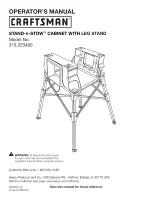
12
Fill the System with Fluid
54. Fill the reservoir using only petroleum based power steering fl uid.
FLUID REQUIREMENT:
The only medium recommended for use in our rack-and-pinion system is
petroleum (OIL). DO NOT USE SILICONE SYNTHETIC FLUID, any automatic transmission fl uid, or any
fl uid containing a “resealing” additive. Materials such as silicones, brake fl uids, water-or glycol-based
hydrostatic fl uids, and phosphate ester-based aviation hydraulic fl uids like Skydrol are incompatible with
the seals in the servo and cylinder and will cause them to swell, shrink, crack, or even dissolve. Damage or
leaks caused by use of these fl uids voids the manufacturer’s warranty.
55. Turn the steering wheel lock to lock repeatedly while maintaining the fl uid level in the reservoir to fi ll the
rack cylinder and hard lines. DO NOT start the engine at this time.
56. Verify that the power steering pump belt is correctly tensioned and then start the engine.
• Top off the fl uid level immediately to replace the volume of fl uid required to fi ll the hoses.
• Operating the power steering pump without fl uid will cause damage.
57. Turn the steering wheel lock to lock repeatedly to bleed air from the system.
Check for Air in the System
58. With the reservoir cap removed, check the fl uid returning to the reservoir for signs of air being introduced
into the system. Potential causes can include the following:
• Splashing from fl uid return can be eliminated by raising the fl uid level.
• Air drawn in from the reservoir feed line due to extremely low fl uid level requires adding fl uid.
• Air drawn in through leaky fi tting on feed line to pump. The fl uid demand from the pump creates a low
pressure condition that can suck in air if the fi ttings are not completely sealed.
Check for Fluid Leaks
59. Each rack and pinion is factory tested at fl uid pressure levels that exceed normal operating conditions.
60. Turn off the engine before checking the entire system for signs of leaking fl uid.
61. Check each connection point on the reservoir, pump, and rack and pinion. Fix any leaks.
• Hose to hose ends
• Hose ends to fi ttings
• Fittings to mounting bosses at the reservoir, pump, and rack.
• Servo base to pinion housing
Verify Steering Bias is Centered
62. With the engine running, lightly throw the steering wheel in either direction.
• If the steering system continues to drift in that direction, the steering bias is offset and must be adjusted.
• Conduct this test in both directions.
Adjusting Steering Bias
•
Prior to shipping servos are adjusted to provide centered or neutral steering effort for vehicles with
symmetrical alignment settings. The vast majority of installations should retain the factory setting.
•
The control servo features two set screws, 90° apart, at the base of the pinion shaft to adjust steering bias.
Each set screw is seated against a fl at on the torsion bar within the pinion shaft and control servo. The
torsion bar controls the operation of the spool valve that directs fl uid to provide hydraulic assist. Offsetting
the center position of the torsion bar by adjusting the set screws alters the balance of constant pressure
directed to each side of the rack-and-pinion piston.
Summary of Contents for RCKP214
Page 3: ...2 1967 70 Mustang Optional use Included in TCP EE 02 Manual Rack assembly is shown in diagram...
Page 15: ...14 NOTES...
Page 16: ...15...
Page 28: ...7 NOTES...
Page 35: ...6 NOTES...
Page 36: ...7 NOTES...














































